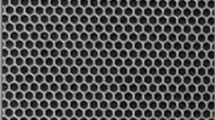Abstract
In this study, the validity of the Eshelby-type model for predicting the effective Young’s modulus and in-plane Poisson’s ratio of the 2-dimensional perforated plate has been investigated in terms of the porosity size and its arrangement. The predicted results by the Eshelbytype model are compared with those by finite element analysis. Whenever the ratio of the porosity size to the specimen size becomes smaller than 0.07, the effective elastic constants predicted by finite element analysis are convergent regardless of the arrangement of the porosities. Under these conditions, the effective Young’s moduli of the perforated plate can be predicted within the accuracy of 5% by the Eshelby-type model, which overestimates and underestimates the effective Poisson’s ratios by 10% and 6% for the plates with periodically and non-periodically arranged porosities, respectively.
Similar content being viewed by others
Abbreviations
- λ :
-
Lame’s constant
- μ :
-
Lame’s constant
- ν :
-
Poisson’s ratio
- σℴ :
-
Applied stress
- Ω :
-
Porosities domain
- D=Ω :
-
Solid domain
- C :
-
Stiffness
- d :
-
Diameter of the porosity
- E :
-
Young’s modulus of the solid
- e° :
-
Strain field induced in the solid without porosities by σ°
- ē :
-
Average disturbance of the strain field in the solid
- e :
-
Disturbed strain field in the porosities
- e* :
-
Eigenstrain field of Eshelby’s equivalent inclusion method
- ec :
-
Total strain field of the perforated plate
- em :
-
Total strain field in the solid
- ep :
-
Total strain field in the porosities
- f :
-
Volume fraction of porosities
- L :
-
Length of the perforated plate
- N :
-
Number of the porosities
- S :
-
Eshelby tensor
- W :
-
Width of the perforated plate
- c :
-
The perforated plate
- m :
-
Solid
- p :
-
Porosities
References
Chung, I., 2004, “Evaluation of In-Plane Effective Properties of Circular-Hole Perforated Sheet,”Journal of the Korean Society of Precision Engineering, Vol. 21, No. 1, pp. 181–188.
Dunn, M. L. and Taya, M., 1993, “Electromechanical Properties of Porous Piezoelectric Ceramics,”J. Am. Ceram. Soc, Vol. 76, No. 7, pp. 1697–1706.
Entchev, P.B. and Lagoudas, D.C., 2004, “Modeling of Transformation-Induced Plasticity and its Effect on the Behavior of Porous Shape Memory Alloys. Part II: Porous SMA Response,”Mechanics of Materials, Vol. 36, No. 9, pp. 893–913.
Eshelby, J. D., 1957, “The Determination of the Elastic Field of an Ellipsoidal Inclusion and Related Problems,”Proc. of the Royal Society of London, Vol. A241, pp. 376–396.
Lee, J. H., 1995, “Simplified Stress Analysis of Perforated Plates Using Homogenization Technique,”j. Computational Structural Engineering, Vol.8, No. 3, pp. 51–58.
Lee, J. K. and Kim, G. D., 2005, “A Theoretical Comparison of Two Possible Shape Memory Processes in Shape Memory Alloy Reinforced Metal Matrix Composite,”Journal of Mechanical Science and Engineering, Vol. 19, No. 7, pp. 1460–1468.
Mori, T. and Tanaka, K., 1973, “Average Stress in the Matrix and Average Elastic Energy of Materials with Misfitting Inclusions,”Ada Metallurgica, Vol. 21, pp. 571–574.
Qidwai, M. A., Entchev, P. B., Lagoudas, D. C. and DeGiorgi, V. G., 2001, “Modeling of the Thermomechanical Behavior of Porous Shape Memeory Alloys,”International Journal of Solids and Structures, Vol. 38, pp. 8653–8671.
Ryu, K. M., Kwon, Y. J., Kim, J. G., Cho, W. S., Cho, N. H., Whang, C. M. and Yoo, Y. C., 2003, “Evolution of Microstructure and Mechanical Properties of Porous Al alloy Under Various Heat Treatment,”Trans. Materials Processing, Vol. 12, No. 6, pp. 588–596.
Tandon, G. P. and Weng, G. J., 1986, “Average Stress in the Matrix and Effective Moduli of Randomly Oriented Composites,”Composites Science and Technology, Vol. 27, pp. 111–132.
Ting, R. Y., 1985, “Piezoelectric Properties of a Porous PZT Cermaic,”Ferroelectrics, Vol. 65, pp. 11–20.
Wu, T. L., 2000, “Micromechanics Determination of Electroelastic Properties of Piezoelectric Materials Containing Voids,”Materials Science and Engineering, Vol. A280, pp. 320–327.
Zhao, Y. O., Tandon, G. P., and Weng, G. J., 1989, “Elastic Moduli for a Class of Porous Materials,”Ada Mechanica, Vol. 76, pp. 105–130.
Author information
Authors and Affiliations
Corresponding author
Rights and permissions
About this article
Cite this article
Lee, JK., Kim, JG. An analytical study on prediction of effective elastic constants of perforated plate. J Mech Sci Technol 19, 2224–2230 (2005). https://doi.org/10.1007/BF02916462
Received:
Revised:
Issue Date:
DOI: https://doi.org/10.1007/BF02916462




